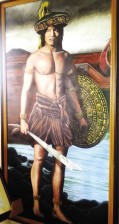Homage to local hero endures in Pampanga town

A PORTRAIT of Bambalito, also known as Tarik Soliman or “the brave youth from Macabebe,” as depicted by local historian and artist Joel Mallari. E.I. REYMOND T. OREJAS/INQUIRER CENTRAL LUZON
MACABEBE, Pampanga—A native hero, recently asserted by local historians as the first Filipino leader killed while repulsing Spanish colonialism in 1571, has emerged from the margins, his courage honored for four straight years now.
“Bambalito” or “the brave youth from Macabebe”—the name and description cited in historical documents on the Battle of Bangkusay in Tondo on June 3, 1571—was honored on his 442nd death anniversary through a series of lectures for the youth and an exhibit about him and this coastal town.
The program was organized by Katatagan (Katipunan da reng Talasaliksik at Talaturung Kapampangan Inc.). In the past three years, the activity was limited to wreath-laying.
Researcher Ian Alfonso said Macabebe town first honored Bambalito in 1934 through a monument dedicated to the “King of Macabebe.”
While Macabebe began organizing activities in his honor in 2010, Bambalito and Magat Salamat had been honored a year earlier in Hagonoy, Bulacan, thanks to a local ordinance, Alfonso said.
What is different and important this time is that a leading cultural heritage advocate, Robby Tantingco, proposed to drop the name “Tarik Soliman” and, in the meantime, refer to Bambalito as “Bangbal.” Some confused him with Rajah Soliman.
“The fact that the name [Tarik Soliman] came from a dubious source, Pedro Paterno, whom [historian] Ambeth Ocampo called the greatest turncoat in Philippine history, pushed the wrong buttons and shifted the debate to the name, not the existence, and certainly not the role in history of ‘the brave youth from Macabebe,’” Tantingco said in a paper presented at the lecture at St. Nicholas Academy here.
Tantingco said the problem about the identity arose because the hero was identified other than his name.
The Spanish navigator and governor, Miguel Lopez de Legazpi, in a letter to the viceroy of New Spain on
Aug. 11, 1572, wrote: “The commander of the heathens lost his life and he was the only one who had obstinately rejected our peace overtures.”
Fray Gaspar de San Agustin, in a document published in 1698, referred to the leader as “the brave youth from Macabebe.”
Martinez de Zuñiga in 1803 described him to be a “general of the indios, who was the king of Macabebe.”
Tantingco said the name Bambalito came up thrice in a fourth document, which was written in 1590 and found in the collection of Don Antonio Graiño and published by Lorenzo Perez in 1933 in a journal.
It said: “Legazpi … sent two Spaniards to see Lacandola and in his house, they met the Macabebes, among whom was their chief named Bambalito, who swore to make war on the Spaniards and challenged them [to meet] in Navotas.”
Citing a Kapampangan scholar’s study of the name, Tantingco said Bangbal must be an apt name for what it stands: a leader, great partner, a hindrance. Tonette Orejas, Inquirer Central Luzon














